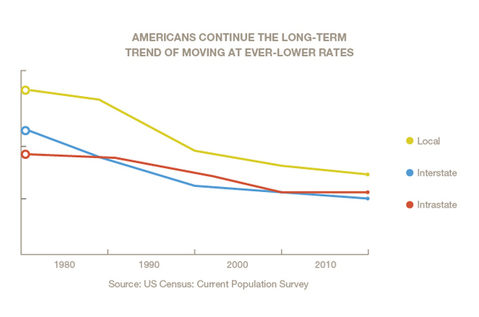Industry Trends
Marketing Insights
People aren’t moving like they used to.
The rate by which Americans are packing up and moving to a new home is at a near-record low of 11.7 percent. At first, everyone attributed the decline to the housing bubble. People stayed put, cocooned in their homes, trapped by low home sales and depressed home prices.
But, as the housing market has ever-so-slowly recovered, moving rates remain low. Even in this more favorable housing market, as Yogi Berra might say, “they’re staying home in droves.”
How come?
First: economics. Especially when it comes to interstate career moves, the financial incentives for uprooting a family are diminishing over the long term. Americans are moving less frequently, even over shorter distances, because it's not worthwhile from an economic standpoint.
Evidence also reveals that many cities are becoming more specialized, tied to specific industries and careers. Young people are choosing a home market early in their career with the specific intent of staying in that career, in that market, specifically so they don’t have to move. For all the talk of multi-careerists, the actual data suggests that Americans are changing jobs, occupations and industries less over time.
Life stage plays an important role, too. The rate at which people move declines steeply with age, and Americans overall are aging. But even younger Americans are moving shorter distances and less frequently.
And that may be what matters most. From the 1950s through the 1970s, the numbers reveal a culture of opportunists. Young, “boomer” Americans moved a lot, whether across town or across the country – following economic and lifestyle opportunities they found attractive.
This began to change in the 1980s and continues today. Trending rates for all forms of moving including local, intrastate and interstate remain in a long, 30-year decline.
What does that mean for brands?
- Invest in homeowners
Marketers of non-disposable, household and home-related brands can know that the predominance of their home-owning customers are staying put, in their current homes. For home brands, an investment in nurturing a long-term customer relationship with American homeowners is as near a sure bet as marketing gets. - Don’t just profile the “decision-maker”
Marketing to homeowners is not simple or straightforward. Buying cycles can be extended with different influencers coming into play. It’s vital to develop deep audience profiles of decision-makers and their pertinent influencers (contractors, designers, friends/family) to get a true picture of the purchasing journey. - Promise to improve not just the home, but the experience of living in it
Marketers of building and remodeling products need to go beyond their traditional price/value message and talk about how their products make everyday living in the home better.
The takeaway? Put your marketing money where it counts: at home.


